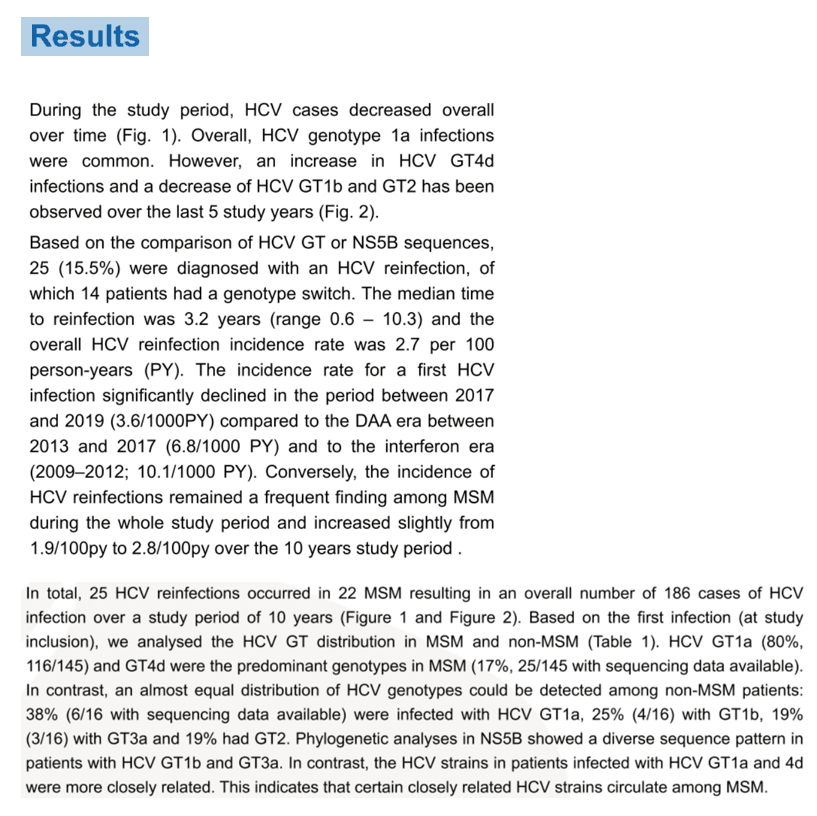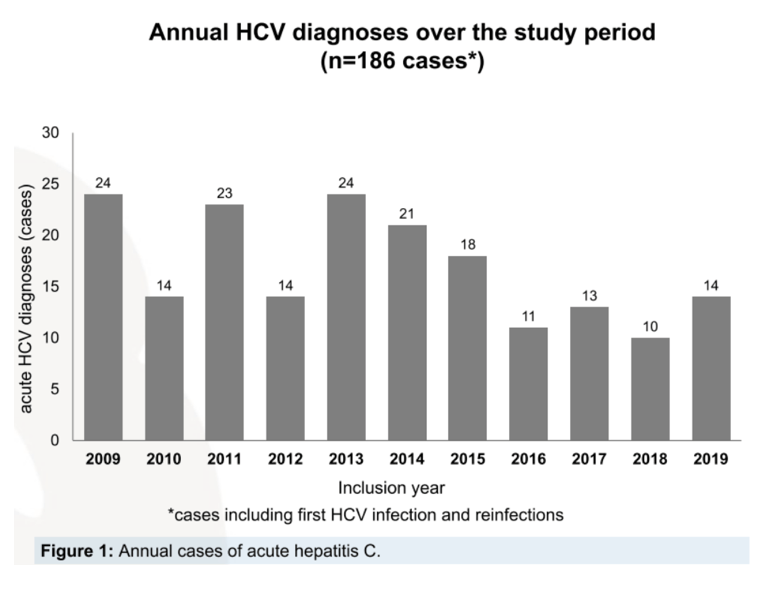 |
 |
 |
| |
RESULTS OF A TEN YEAR PROSPECTIVE OBSERVATIONAL STUDY ON ACUTE
HEPATITIS C IN HCV-MONO- AND HCV/HIV-
COINFECTED PATIENTS
|
| |
| |

AASLD 2021 Nov 12-15
Christiana Graf1, Lara Fuhrmann2, Thomas Lutz3, Gaby Knecht3, Christoph Stephan4, Peter Gute3, Markus Bickel3, Kai-Henrik Peiffer5, Georg Dultz1, Fabian Finkelmeier5, Stefan Zeuzem5, Niko Beerenwinkel2, Julia Dietz1 and Christoph Sarrazin1,6, (1)Department of Internal Medicine I, Goethe University Hospital Frankfurt, Germany, (2)Swiss Federal Institute of Technology Zurich, Basel, Switzerland, (3)Infektiologikum Frankfurt, Germany, (4)Department of Infectious Diseases, Goethe University Hospital Frankfurt, Germany, (5)Internal Medicine I, Hospital of the Goethe University Frankfurt, (6)St. Josefs-Hospital Wiesbaden, Germany
Background: Over the last two decades, a persistent epidemic of acute Hepatitis C virus (HCV) infections has been observed in HIV-positive men who have sex with men (MSM) in several metropolitan areas worldwide. In this study, epidemiological and clinical parameters as well as phylogenetic analyses were conducted to characterize HCV transmission among MSM.
Methods: This prospective observational study analysed clinical and epidemiological parameters of patients with confirmed acute HCV infection between 2009 and 2019 from 3 centers in Frankfurt. NS5B population-based sequencing was performed at the time of diagnosis to determine HCV genotype (GT) and for phylogenetic analyses.
Results: A total of n=161 patients diagnosed with acute HCV-infection were included in the study, of whom n=140 (87%) were HIV-positive and n=145 (90%) were MSM. We observed a different distribution of HCV genotypes over time. In the first eight years, HCV GT1a was most common (58-100%) but decreased to 30% in 2018. In contrast, the proportion of GT4d cases increased. While no GT4d cases were diagnosed in 2013, the proportion rose to 40% in 2019. There was a slight trend towards more GT3a cases in 2018 and 2019, while for GT1b and GT2 only individual cases were detected between 2009 and 2014. MSM were mainly infected with HCV GT1a (82%, 115/140) or GT4d (16%, 23/140 with sequencing data available). In contrast, HCV genotypes were almost equally distributed in non-MSM patients. Here, 36% were infected with HCV GT1a, 21% each with GT1b or GT3a and 16% had GT2. Phylogenetic analyses in NS5B showed a diverse sequence pattern in patients with HCV GT1b and GT3a. In contrast, HCV strains among MSM infected with HCV GT1a and 4d were more closely related. Based on the comparison of HCV genotypes or NS5B sequences, 24 patients (15%) were diagnosed with an HCV reinfection. The incidence rate in MSM for a first HCV infection declined in the period between 2017 and 2019 (3.8/1000PY) compared to the DAA era between 2013 and 2017 (6.7/1000 PY) and to the interferon era (2008-2013; 10/1000 PY). Conversely, the incidence of HCV reinfections among MSM increased slightly from 1.6/100PY to 2.3/100PY over time.
Conclusion: During the last 5 study years the prevalence of GT4 infections increased, while annual acute hepatitis C incidences decreased. HCV reinfection is an issue of major concern in HIV-positive MSM and may have implications for HCV elimination.





|
| |
|
 |
 |
|
|